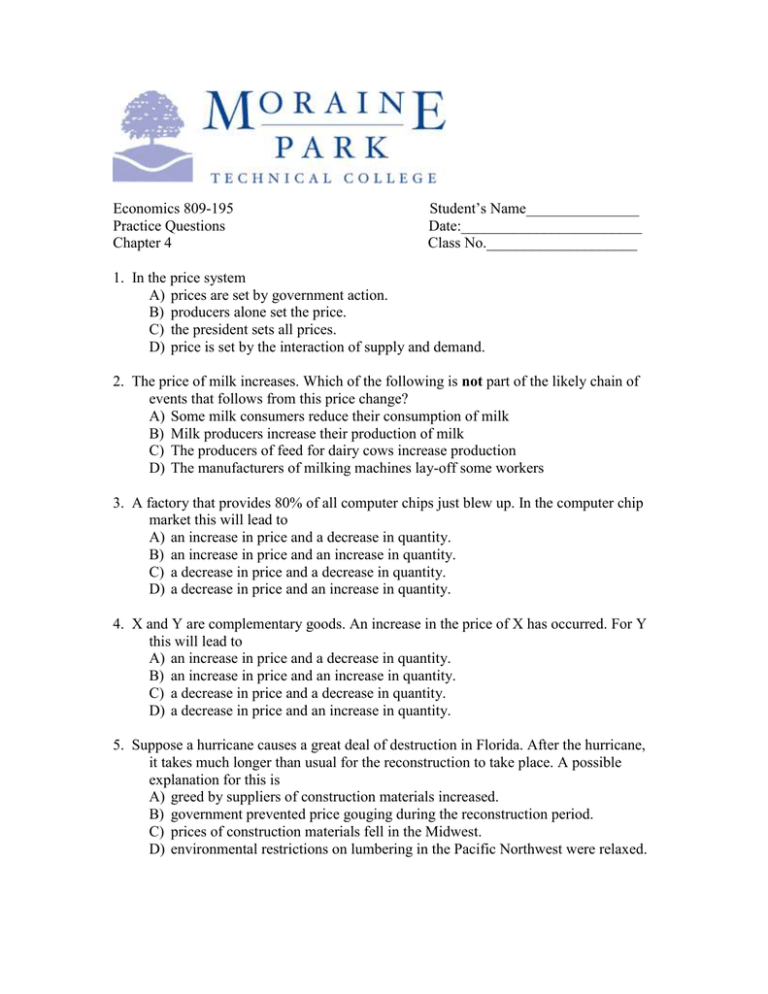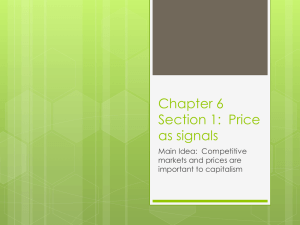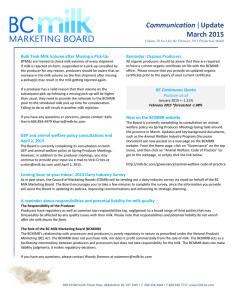Economics 809-195 ... Practice Questions ...
advertisement

Economics 809-195 Practice Questions Chapter 4 Student’s Name_______________ Date:________________________ Class No.____________________ 1. In the price system A) prices are set by government action. B) producers alone set the price. C) the president sets all prices. D) price is set by the interaction of supply and demand. 2. The price of milk increases. Which of the following is not part of the likely chain of events that follows from this price change? A) Some milk consumers reduce their consumption of milk B) Milk producers increase their production of milk C) The producers of feed for dairy cows increase production D) The manufacturers of milking machines lay-off some workers 3. A factory that provides 80% of all computer chips just blew up. In the computer chip market this will lead to A) an increase in price and a decrease in quantity. B) an increase in price and an increase in quantity. C) a decrease in price and a decrease in quantity. D) a decrease in price and an increase in quantity. 4. X and Y are complementary goods. An increase in the price of X has occurred. For Y this will lead to A) an increase in price and a decrease in quantity. B) an increase in price and an increase in quantity. C) a decrease in price and a decrease in quantity. D) a decrease in price and an increase in quantity. 5. Suppose a hurricane causes a great deal of destruction in Florida. After the hurricane, it takes much longer than usual for the reconstruction to take place. A possible explanation for this is A) greed by suppliers of construction materials increased. B) government prevented price gouging during the reconstruction period. C) prices of construction materials fell in the Midwest. D) environmental restrictions on lumbering in the Pacific Northwest were relaxed. 6. Prices ration goods to A) the people who most deserve it. B) the people with the lowest opportunity cost of time. C) the people willing and able to pay the highest price. D) the richest people. 7. A price floor is A) the lowest price a seller can charge without losing all of its customers. B) a legal minimum price below which a good or service cannot be sold. C) a legal maximum price that can be charged for a good or service. D) a nonprice rationing device. 8. A price ceiling will usually cause A) nonprice rationing. B) an excess supply. C) an increase in the market clearing price. D) a decrease in the market clearing price. 9. An example of a black market is A) the market for high fashions. B) the hiring of undocumented workers. C) a farmer’s market. D) a discount market. Figure 4.3 10. Refer to the above figure. If a price ceiling of $3 was set A) quantity sold would be 80 units. B) there would be a surplus of 40 units. C) there would be a shortage of 40 units. D) there would be a shortage of 20 units. 11. When the government sets a price floor which is below the equilibrium price A) a surplus will develop. B) a shortage will develop. C) the equilibrium price will be maintained. D) a price ceiling will follow. Figure 4.4 12. Refer to the above figure. A minimum wage has been set at WM. The amount of unemployment is A) zero. B) at Qe. C) QS minus QD. D) not computable from the information given. 13. Suppose local educators argue that teachers’ salaries are too low. At the same time it is said that the school district received 750 applications for 5 new openings. Are salaries too low? Explain.




